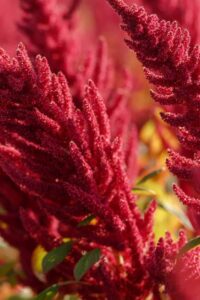- Vernacular Name: Pearl millet is known as Sajje in Kannada, ‘Bajri’ in Gujarati, ‘Bajra’ in Hindi, , ‘Kambu’ in Tamil, ‘Sajjalu’ in Telugu, ‘Bajeer’ in Kumaoni, and ‘Maiwa’ in Hausa language.
- Origin: Pearl millet (Pennisetum glaucum), also known as bajra or bulrush millet, is a cereal crop grown primarily in arid and semiarid regions of Africa and Asia. It is believed to have originated in Africa and has been cultivated for thousands of years. Pearl millet is known for its resilience in harsh environmental conditions, including drought and poor soil fertility. Pearl millet is the most economically significant small-seeded millet species, cultivated across 26 million hectares. Around 2000 BC, it spread to India and became a major staple crop.
- Plants parts: Pearl millet (Pennisetum glaucum) is a resilient cereal crop with several distinct plant parts, each contributing to its agricultural and nutritional significance. The most prominent part is the grain, which is small, ovoid, and varies in color from white to yellow, brown, and purple. These grains are rich in carbohydrates, protein, dietary fiber, and essential minerals, making them a staple food in many regions, particularly in Africa and India. The leaves of pearl millet are long and linear, typically ranging from 20 to 100 cm in length and 0.5 to 5.0 cm in width. They can be hairy or glabrous, and they are important for photosynthesis and growth. The leaves are also utilized as fodder for livestock, providing a nutritious feed source. The stems of the plant are erect and can grow up to 2 to 4 meters tall, with a diameter of 0.5 to 1.5 cm.
These stems are generally round to oval in shape and may be soft and palatable, making them suitable for foraging. The stems also play a role in supporting the plant and facilitating nutrient transport. The inflorescence of pearl millet is a terminal spike that bears the flowers, which are crucial for grain production. The flowers are arranged in a panicle, and the seeds develop from these flowers. While the inflorescence is not typically consumed directly, it is essential for the reproductive process of the plant.
- Geographical area: Pearl millet (Pennisetum glaucum) is extensively cultivated across India, particularly in arid and semi-arid regions. The major states for pearl millet production include Rajasthan, Maharashtra, Gujarat, Haryana, and Uttar Pradesh, which together account for over 90% of the total area under cultivation. Rajasthan is the leading producer, especially in its western and southwestern regions, where the crop thrives due to its drought tolerance and adaptability to low-fertility soils. In India, pearl millet is primarily grown during the rainy (kharif) season from June to October, although it is also cultivated in the summer (February to May) and post-rainy (Rabi) seasons in some areas. The crop is well-suited to regions characterized by low and erratic rainfall, high temperatures, and poor soil conditions, making it a vital food source in areas where other crops may fail.
As of recent estimates, pearl millet occupies approximately 6.93 million hectares in India, with an average production of around 8.61 million metric tons. Its grains are valued for their nutritional benefits, including high protein content, dietary fiber, and essential minerals, which contribute to food security and nutritional health. The government has recognized pearl millet as a “nutrient cereal,” promoting its cultivation and consumption to enhance dietary diversity and address malnutrition.
- Functional properties:
- Water Absorption Capacity: Pearl millet flour has a notable water absorption capacity, which is essential for various food formulations. This property influences the texture and moisture retention of baked goods and other products.
- Industrial use: Beyond its use as a food and fodder crop, pearl millet has a variety of industrial applications. Its grains can be ground into flour for use in traditional dishes like bread, porridge, and snacks. Furthermore, pearl millet straw and stalks are used in a variety of industries, including paper making, construction materials, and biofuel generation, demonstrating its economic adaptability.
- Fodder and Forage: Pearl millet is also used as a livestock feed crop due to its high biomass production and nutritional value. Farmers feed their animals the entire plant, including the leaves, stems, and grains, which helps to improve cattle health and productivity. This dual-purpose nature increases its economic significance by providing extra income streams to farmers.
- Nutritional composition: Pearl millet contains vital nutrients such as carbs, proteins, dietary fiber, vitamins, and minerals. It serves as a good source of energy, making it a staple diet in many regions where it is farmed.
- Digestive health: Pearl millet contains dietary fiber, which assists digestion and promotes gastrointestinal health. Consuming fiber-rich meals can help prevent constipation, regulate bowel motions, and improve overall digestive function.
- Antioxidant properties: Pearl millet includes phytochemicals with antioxidant characteristics, including phenolic compounds and flavonoids. These antioxidants assist in neutralizing free radicals in the body, lowering oxidative stress, and protecting against chronic diseases like heart disease, cancer, and inflammation.


